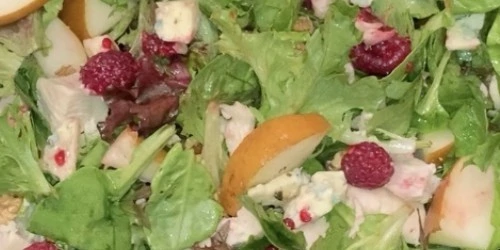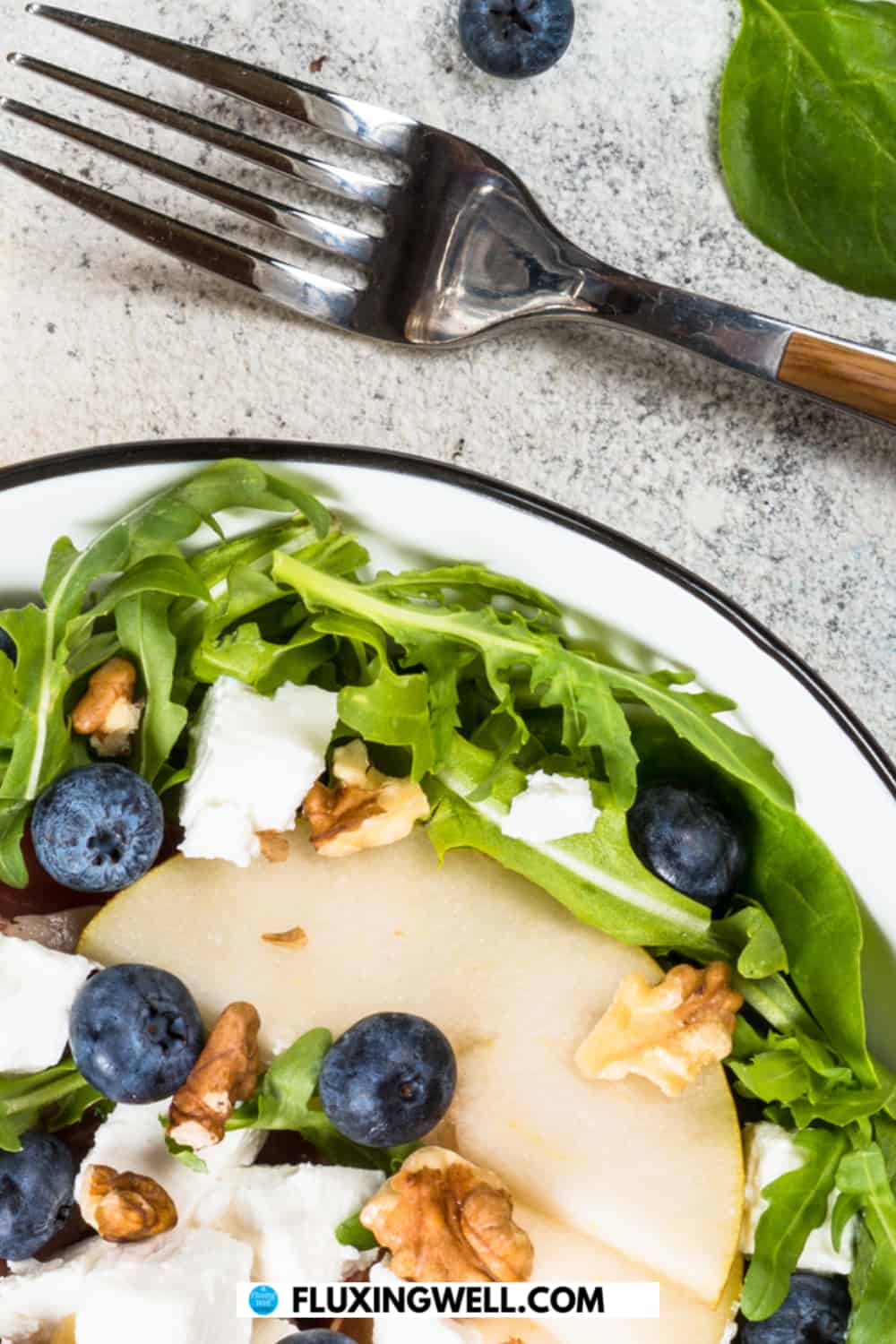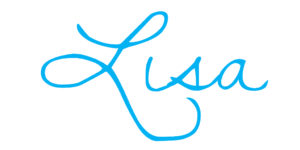Combine delicious fall flavors in this easy walnut pear blue cheese salad recipe. Looking for a simple weeknight meal? You can add chicken to this salad for a chicken pear blue cheese salad. The best part? You can make this salad in just 15 minutes. Serve it with some cornbread or homemade rolls. A nice fall cabbage soup recipe would also pair well with this salad. There are many possibilities. Read on to learn how to make this tasty walnut pear blue cheese salad and its different variations.
Table of Contents
The Walnut Pear Blue Cheese Salad Backstory
The idea for this recipe came from an unlikely place: A real estate flyer! The picture of the pear blue cheese and walnut salad looked so enticing that I couldn’t resist giving it a try. Who could pass up a salad recipe made with sweet, juicy pears, crunchy walnuts, and tangy blue cheese? I didn’t have all of the ingredients on hand, though, so I made a few substitutions. Our raspberry crop was very small this year, but I wanted to make the best use of the few raspberries I had available to me. In order to make it a meal, I needed to add some meat, so this chicken, pear, walnut raspberry blue cheese salad was created. See what you think!
Equipment for Walnut Pear Blue Cheese Salad
This post contains affiliate links, which means I may earn a small commission from qualifying purchases at no additional cost to you. Please read my Policies page for more information.
There is no need for any fancy equipment to make this easy walnut pear blue cheese salad recipe. You do need a skillet for toasting the walnuts, a large salad bowl and a small jar with a lid for mixing the dressing. A bowl with a lid is nice. I have this entire set, and I like the way I can mix and serve the salad in the large bowl, then store leftovers in a smaller bowl, if needed.
Ingredients for Walnut Pear Blue Cheese Salad
During the fall harvest season, the fresh pears are readily available. Check your freezer to see if you have a stash of walnuts. I found some, and they were just right for this recipe. The most economical place to purchase blue cheese is Grocery Outlet. I love their cheese section! If you don’t have one near you, Trader Joe’s offers a wide variety of cheese as well. Here is what you will need for the basic recipe:
6 cups mixed salad greens
1 cup cooked leftover rotisserie chicken or cooked, chopped chicken breasts
1-2 large pears, sliced
1/2 cup walnuts, toasted
1/2-1 cup ripe raspberries or blueberries (frozen berries may be used as well)
1/2 cup blue cheese, crumbled
Ingredients for the dressing:
3 tablespoons lemon juice (fresh squeezed is best, but bottled is okay as well)
2 tablespoons olive oil
1 tablespoon honey
2 teaspoons dijon mustard
1/4 teaspoon salt
1/8 teaspoon pepper
Directions for Walnut Pear Blue Cheese Salad
To make the pear walnut blue cheese salad dressing, combine all ingredients in a small jar with a lid. Shake well to mix the ingredients, then set the jar aside.
Add walnuts to a skillet and toast over medium heat. Stir constantly for a couple of minutes to avoid scorching the walnuts. When the walnuts are fragrant and golden, remove from the heat and let cool.
In a large salad bowl, toss greens with 2 tablespoons of the dressing. Slice the pears thinly and add to the salad. Toss gently. Sprinkle on the walnuts, blue cheese, and raspberries. Serve the dressing on the side. This recipe makes 4 servings.

Walnut Pear Blue Cheese Salad Recipe
Equipment
- 1 skillet
- 1 bowl lid is optional, but nice
- 1 small jar with lid
Ingredients
- 6 cups mixed salad greens
- 1 cup chopped, cooked chicken
- 1-2 fresh pears, sliced
- ½ cup walnuts, toasted
- ½-1 cup ripe, fresh raspberries
- ½ cup blue cheese, crumbled
Dressing
- 3 tablespoons lemon juice
- 2 tablespoons olive oil
- 1 tablespoon honey
- 2 teaspoons dijon mustard
- ¼ teaspoon salt
- ⅛ teaspoon pepper
Instructions
- To make the pear walnut blue cheese salad dressing, combine all ingredients in a small jar with a lid. Shake well to mix the ingredients, then set the jar aside.
- Add walnuts to a skillet and toast over medium heat. Stir constantly for a couple of minutes to avoid scorching the walnuts. When the walnuts are fragrant and golden, remove from the heat and let cool.
- In a large salad bowl, toss greens with 2 tablespoons of the dressing. Slice the pears thinly and add to the salad. Toss gently. Sprinkle on the walnuts, blue cheese, and raspberries. Serve the dressing on the side. This recipe makes 4 servings.
Walnut Pear Blue Cheese Salad Variations
One of the great things about this salad recipe is the many ingredient substitutions that may be made. Change up the flavor with one of these simple ideas. Try one of these other pear blue cheese salad recipes.
Pear Blue Cheese Pecan Salad
To create this salad variation, just substitute pecans for the walnuts. You can toast the pecans if you wish, or add them without toasting. The salad will retain its delicious crunch with a slightly different flavor.
Walnut Pear Blue Cheese Romaine Salad
Instead of the mixed salad greens, opt for some romaine lettuce. Add it as you would the greens, then combine it with the other ingredients. Romaine lettuce is nutrient-rich as well as deliciously crunchy.
Walnut Pear Blue Cheese Grape Salad
Instead of using raspberries, substitute in another fall fruit: Grapes. Our grapes don’t usually ripen enough to be edible, but this fall was an exception. Cut the grapes in half for an easy salad mix-in.
Walnut Pear Feta Blueberry Salad
Instead of blue cheese, use crumbled feta cheese. Add in blueberries instead of raspberries or grapes. You can even add a can of chicken to make it a meal.
What to Serve with Pear and Blue Cheese Salad?
This salad is an excellent main dish when chicken is included, and pairs well with soup. French onion soup (without the sausage added in) would be a flavorful choice. As noted in the introduction, cornbread or homemade rolls are tasty side dishes to serve alongside this salad. Blue cheese has a strong, unique taste, so it works well when accompanied by mellow, subtle flavors. Roasted rosemary red potatoes would be a simple side dish that would complement the blue cheese in the salad.
Frequently Asked Questions About Blue (Bleu) Cheese
Since blue cheese (sometimes spelled bleu cheese) is such a major component of this fall salad recipe, some who have never used it before may have questions. Blue cheese is somewhat of an acquired taste, as the taste and smell are so pungent. I was introduced to it at a young age because blue cheese salad dressing was a favorite of my mom’s. Here are some questions some have when using blue cheese in recipes.
Why is Blue Cheese Spelled Bleu?
The spelling “bleu” for blue cheese is derived from the French language. In French, “bleu” is the word for the color blue, and it is commonly used to describe blue-veined cheeses, such as Roquefort, Gorgonzola, and other similar varieties. These cheeses are characterized by the blue or green veins of mold running through them, which give them their distinctive appearance and flavor.
The spelling “bleu” is used in the names of these cheeses to indicate their type and origin, as many of them come from regions in France and Italy where French is spoken. For example:
Roquefort: A famous French blue cheese, often referred to as “Roquefort cheese.”
Bleu d’Auvergne: Another French blue cheese, the name literally means “Blue of Auvergne,” referring to the region in France where it is produced.
Gorgonzola: An Italian blue cheese, but the name itself has French origins. It’s believed to be derived from “Gorgonzola,” a town in Italy, but it incorporates the French word “bleu” to describe its characteristic blue veins.
So, the use of “bleu” in the spelling of blue cheese is a linguistic and cultural choice that reflects the French influence on the naming and classification of these cheeses.
Is blue cheese healthy?
Blue cheese, like many other foods, can be a part of a healthy diet when consumed in moderation. It has both potential health benefits and considerations to keep in mind:
Health Benefits:
Protein: Blue cheese, like all cheeses, contains protein, which is essential for building and repairing tissues in the body.
Calcium: Cheese, including blue cheese, is a good source of calcium, which is important for strong bones and teeth.
Vitamins and Minerals: Blue cheese contains vitamins and minerals, including vitamin A, vitamin B12, and zinc.
Probiotics: Some blue cheeses are made with cultures that contain probiotics, which can be beneficial for gut health.
Antioxidants: Blue cheese may contain antioxidants due to the presence of the blue or green mold cultures used in its production.
Considerations:
Calories and Fat: Blue cheese is relatively high in calories and fat, particularly saturated fat. This makes portion control important, as excessive consumption can contribute to weight gain and potential heart health concerns.
Sodium: Blue cheese can be quite salty, and a high-sodium diet is linked to hypertension (high blood pressure) in some individuals. If you have hypertension or are sensitive to sodium, you should consume blue cheese in moderation.
Lactose: Some people are lactose intolerant and may experience digestive discomfort when consuming dairy products like blue cheese. However, aged cheeses like blue cheese generally contain lower levels of lactose and may be better tolerated by some individuals.
Allergies: Blue cheese contains mold, which can trigger allergic reactions in some people. If you have mold allergies, it’s essential to exercise caution when consuming blue cheese.
Mold Concerns: Blue cheese is intentionally moldy, but any additional mold growth beyond what’s typical for blue cheese can be a sign of spoilage and should be avoided.
Can I melt blue cheese?
Yes, you can melt blue cheese, and it can add a rich and tangy flavor to a variety of dishes when melted. Blue cheese is easy to melt. It would make a fun option to serve as a cheese option when hosting a raclette dinner party. If you aren’t sure what raclette is, basically it’s cheese melted on a special grill, then poured over a variety of meat, vegetables, nuts, and fruit. Does that seem interesting? You can read all about it here. Here are some tips on melting blue cheese:
Use Low to Medium Heat: Blue cheese has a relatively low melting point compared to some other cheeses, so it’s important to use low to medium heat when melting it. High heat can cause the cheese to become grainy or separate.
Cut into Small Pieces: Cut the blue cheese into small, uniform pieces. This will help it melt more evenly and quickly.
Incorporate into Sauces: One common way to use melted blue cheese is by incorporating it into sauces. For example, you can make a creamy blue cheese sauce for pasta or steak by melting the cheese into heavy cream or milk over low heat. Stir continuously until the cheese is fully melted and the sauce is smooth.
Melt on Grilled Meats: Crumble or place small slices of blue cheese on top of hot grilled meats like burgers or steaks just before they finish cooking. The residual heat will melt the cheese, creating a delicious topping.
Melt in the Oven: Blue cheese can also be melted in the oven. Simply crumble or slice it and place it on top of dishes like baked potatoes or casseroles. Bake until the cheese is melted and bubbly.
Melt in the Microwave: You can melt small amounts of blue cheese in the microwave, but be cautious not to overheat it. Use a microwave-safe dish, and heat the cheese in short intervals (15-30 seconds) at medium or low power, stirring between intervals until it reaches the desired consistency.
Keep in mind that melted blue cheese will still retain its pungent flavor, so it’s best used in dishes where the strong flavor complements other ingredients. It’s great for adding depth and richness to creamy sauces, salads, and dishes featuring roasted or grilled meats.
How do you know if blue cheese has gone bad?
It’s a bit ironic that cheese made with mold (yes, the blue veins in the cheese are a type of Penicillium mold that is safe to consume) can get moldy. Blue cheese, like other cheeses, can go bad if it’s not stored properly or if it’s past its shelf life. Here are some signs to look for to determine if blue cheese has gone bad:
Mold Growth: Blue cheese naturally contains mold, which gives it its characteristic blue veining. However, if you notice additional mold growth on the surface that is different from the typical blue or green mold, or if the mold appears fuzzy or of a different color (other than blue or green), it may be a sign that the cheese has gone bad. You can scrape off the surface mold and still consume the cheese if the rest looks and smells fine, but be cautious.
Off or Sour Smell: Fresh blue cheese has a strong, pungent aroma. However, if the cheese develops an off or sour smell that is different from its usual odor, it may indicate spoilage. Trust your sense of smell; if it doesn’t smell right, it’s best to discard it.
Unusual Texture: Check the texture of the blue cheese. If it has become excessively dry, crumbly, or slimy, it may have gone bad. Blue cheese should have a creamy yet crumbly texture when fresh.
Bitter Taste: If the blue cheese has developed a bitter or rancid taste, it is no longer safe to consume.
Visible Spoilage: Look for any signs of visible spoilage, such as unusual discoloration, sliminess, or an oily appearance. These can be indications that the cheese has gone bad.
Packaging Damage: If the blue cheese was stored improperly or if the packaging is damaged, it is more susceptible to spoilage. Check for any holes or openings in the packaging.
Remember that blue cheese can be quite pungent and may have strong flavors, so some changes in taste and aroma might not necessarily indicate spoilage. However, if you notice any of the signs mentioned above, especially mold that doesn’t look like the typical blue or green mold or an off odor, it’s safest to err on the side of caution and discard the cheese. Food safety should always be a priority when consuming dairy products or any perishable foods.
How long is blue cheese good for? How long does blue cheese last once opened?
Blue cheese, like other cheeses, has a relatively long shelf life if stored properly, even after it’s been opened. Here are some general guidelines for how long you can expect blue cheese to last once it’s been opened:
Refrigerated Blue Cheese: When properly stored in the refrigerator at a temperature between 35°F to 45°F (1°C to 7°C), an opened package or block of blue cheese can last for about 1 to 2 weeks. It’s important to keep the cheese tightly wrapped in plastic wrap or aluminum foil to minimize exposure to air, which can cause it to dry out or develop mold.
Crumbled Blue Cheese: Crumbled blue cheese typically has a shorter shelf life once opened compared to a whole block or wheel. Expect crumbled blue cheese to last for about 1 week in the refrigerator if stored in an airtight container.
Blue Cheese Dressing: If you have a blue cheese dressing or dip that contains dairy, its shelf life will depend on the ingredients and preservatives used. Generally, it can last in the refrigerator for about 1 to 2 weeks after opening. Always check the label for specific instructions.
Is it OK to freeze blue cheese?
Yes, you can freeze blue cheese, but it’s important to be aware that freezing may alter the texture and crumbliness of the cheese. Here are some guidelines on freezing blue cheese:
Wrap it Properly: To freeze blue cheese, wrap it tightly in plastic wrap or aluminum foil to minimize its exposure to air. You can also place it in an airtight container or a vacuum-sealed bag to further protect it from freezer burn.
Portion Control: Consider dividing the blue cheese into smaller portions before freezing. This way, you can thaw only what you need without repeatedly exposing the entire block to the freezer’s temperature changes.
Label and Date: Always label the packaging with the date you’re freezing the blue cheese so you can keep track of its freshness.
Freeze Quickly: Put the wrapped or containerized blue cheese in the freezer as soon as possible to maintain its quality. The quicker you freeze it, the better it will retain its flavor and texture.
Thawing: When you’re ready to use the frozen blue cheese, transfer it to the refrigerator and allow it to thaw slowly. This gradual thawing helps preserve the cheese’s flavor and texture. It may take several hours or even overnight to thaw completely.
Use in Cooking: Frozen blue cheese is often better suited for cooking or melting than for serving on a cheese platter. It may crumble more easily after freezing, but its flavor can still be excellent when incorporated into dishes like sauces, dressings, or baked dishes.
Keep in mind that the texture of blue cheese may change after freezing, becoming crumbly or slightly grainy. However, its flavor should remain intact, making it suitable for various culinary applications. If you plan to use the blue cheese in a dish where texture is less critical, such as a salad dressing or pasta sauce, freezing can be a convenient way to extend its shelf life.
What About You and Blue Cheese?
Are you a huge fan of blue cheese? What do you like to top with blue cheese? What do you like to mix blue cheese with? Is there anything in your life that you have improved with the addition of blue cheese? I’d enjoy reading your thoughts and ideas.
More Food Inspiration
It’s always nice to have a plan when it comes to meals. If you’re looking for a way to get more organized with your meal-planning efforts, I’ve got something for you. Free, editable meal planners! The templates can be used over and over, as often as you need them. You can make as many duplicates as you like, and you’ll be able to save old meal plans for future reference. I hope it simplifies things for you.
Get my digital, editable, printable planner!
If you would like even more recipe ideas, consider following my Easy Recipes board on Pinterest. Have a fabulous day, and have a good time trying these walnut pear blue cheese salad recipes.
Lisa Mitchell is a wife, mom, and school librarian who likes to create and share recipes, often using fresh ingredients from her family’s small Pacific Northwest farm. To get more easy recipes, click on over to the Food page.
Like what you read? Please give it a share!
Want more great food, garden, or party ideas? Follow FluxingWell on Pinterest, Flipboard, Facebook, Instagram, and X for the latest posts, tips, and inspiration.






I love pears, cheese, and walnuts, and this walnut pear blue cheese salad recipe is perfect for me! It looks fantastic! Thanks for sharing the recipe and all the variations too.
You are very welcome! I now try to have some blue cheese on hand to sprinkle on many different foods.
This salad looks amazing! I would love to try it out sometime. Thanks for sharing your recipe for it!
I’m so glad it looks good to you, and I hope you do get to try it out.
This looks like such an easy and delicious way to add fall flavors to a salad. I love walnuts, pears, and blue cheese – this sounds perfect! Thanks for sharing!
You are most welcome! I could eat this salad all day long.
I love bleu cheese on hamburgers…..it’s gotten so that I don’t much care for a hamburger without bleu cheese! Thanks for the recipe, I am taking a salad to a dinner this Saturday so it’s perfect timing. Sounds delicious!
Oh, yes, I will have to try bleu cheese on my next hamburger as well. Enjoy the salad!
Yum! This salad has so many of my favorite flavors. I love that it’s delicious and so simple. Thank you for sharing.
You are very welcome! I am so glad you like the flavor combination.